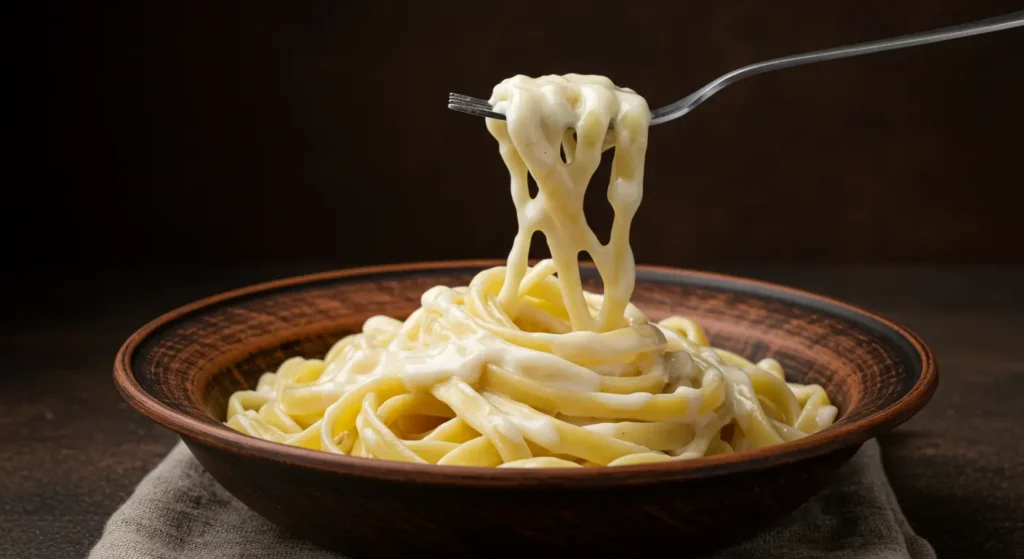Creamy Noodles – Why This Recipe?
As Chef Greeny, I’ve traveled across continents and explored countless cuisines, but there’s something undeniably special about a bowl of creamy noodles that always brings me back to my roots. My journey with this comforting dish began in my grandmother’s kitchen, where she would transform simple ingredients into a silky, indulgent meal that warmed both body and soul.
What makes creamy noodles so irresistible isn’t just their velvety texture or rich flavor—it’s their incredible versatility. Whether you’re craving something quick after a long workday or preparing a special dinner for loved ones, this dish adapts to any occasion.
In today’s blog post, I’m sharing my perfected creamy noodles recipe, along with variations that I’ve developed over years of culinary exploration. You’ll learn not just how to make the perfect creamy sauce that clings to every strand of pasta, but also how to customize it to your dietary needs and flavor preferences. From understanding the ideal pasta-to-sauce ratio to mastering the technique of creating silky smoothness without clumping, this guide will elevate your noodle game to restaurant quality.
Let’s dive into the comforting world of creamy noodles together!
Creamy Noodles – Ingredients and Preparation
Ingredients List
For the base creamy noodles recipe (serves 4):
- 12 oz (340g) fettuccine or linguine (can substitute with any pasta of choice)
- 2 tablespoons unsalted butter
- 2 cloves garlic, minced
- 1 cup heavy cream
- 1 cup freshly grated Parmesan cheese
- ¼ teaspoon freshly ground black pepper
- ¼ teaspoon salt (adjust to taste)
- Fresh parsley for garnish (optional)
Substitution options:
- Gluten-free: Use gluten-free pasta made from rice, corn, or chickpea flour
- Dairy-free/Vegan: Substitute heavy cream with full-fat coconut milk or cashew cream, vegan butter instead of regular butter, and nutritional yeast or vegan Parmesan alternatives
- Lighter option: Use half-and-half or whole milk instead of heavy cream (may require a thickening agent like a roux)
Step-by-Step Instructions
- Cook the pasta: Bring a large pot of salted water to a boil. Add the pasta and cook according to package instructions until al dente (usually 8-10 minutes). Reserve ½ cup of pasta water before draining.
- Chef’s tip: Salting your pasta water is crucial! It should taste like seawater to properly season the pasta from within.
- Prepare the sauce base: While the pasta cooks, melt butter in a large skillet over medium heat. Add minced garlic and sauté for 30 seconds until fragrant but not browned.
- Chef’s tip: Browning the garlic will create a bitter taste, so keep a close eye on it!
- Create the cream base: Pour the heavy cream into the skillet and bring to a gentle simmer. Let it reduce slightly for about 2-3 minutes, stirring occasionally.
- Chef’s tip: Don’t let the cream come to a full boil as it might separate.
- Add the cheese: Reduce heat to low and gradually whisk in the Parmesan cheese until fully melted and the sauce is smooth.
- Chef’s tip: Grate your cheese fresh rather than using pre-packaged shredded cheese, which contains anti-caking agents that can prevent proper melting.
- Season the sauce: Add salt and freshly ground black pepper. Taste and adjust seasonings as needed.
- Combine with pasta: Add the drained pasta to the sauce, tossing gently with tongs to coat evenly. If the sauce is too thick, add a splash of the reserved pasta water to reach your desired consistency.
- Chef’s tip: The starchy pasta water helps the sauce cling to the noodles better than plain water would.
- Finish and serve: Cook for another minute to allow the pasta to absorb some of the sauce. Remove from heat and serve immediately, garnished with additional Parmesan cheese and chopped fresh parsley if desired.
Notes and Tips
- Storage: Creamy noodles are best enjoyed fresh, but leftovers can be stored in an airtight container in the refrigerator for up to 2 days. The sauce will thicken considerably when chilled.
- Reheating: When reheating, add a splash of milk or cream and warm gently over low heat, stirring frequently to prevent the sauce from separating.
- Make-ahead instructions: If you need to prepare components in advance, you can cook the pasta ahead of time (slightly undercook it), toss with a little olive oil to prevent sticking, and refrigerate. The sauce is best made fresh, but can be prepared up to 24 hours ahead and gently reheated before combining with the pasta.
- Serving suggestions: Creamy noodles pair wonderfully with a simple green salad, roasted vegetables, or protein of choice like grilled chicken, sautéed shrimp, or roasted mushrooms for a vegetarian option.
Creamy Noodles – Nutritional Information
Nutrition Facts (Per Serving)
| Nutrient | Amount |
|---|---|
| Calories | 520 |
| Carbohydrates | 48g |
| Protein | 15g |
| Total Fat | 30g |
| Saturated Fat | 18g |
| Unsaturated Fat | 10g |
| Trans Fat | 0g |
| Fiber | 2g |
| Sugar | 3g |
| Cholesterol | 95mg |
| Sodium | 450mg |
Note: Nutritional values are approximate and may vary depending on specific ingredients used.
Creamy Noodles – History and Cultural Significance
Creamy noodle dishes have a rich history that spans multiple cultures and cuisines. The concept of combining pasta with a creamy sauce can be traced back to ancient Rome, where cooks would mix fresh cheese with cooked noodles to create a simple yet satisfying meal.
However, what we recognize today as creamy noodles has its strongest roots in Italian cuisine, particularly in the form of dishes like Alfredo and carbonara. Fettuccine Alfredo was famously created in 1920s Rome by restaurateur Alfredo di Lelio, who made a simple pasta dish with butter and Parmesan cheese to appeal to his pregnant wife’s delicate appetite. This dish eventually evolved to include cream in many modern interpretations, especially in American cuisine.
In Eastern European traditions, noodles with farmer’s cheese, cream, and sometimes sugar create a comfort food that’s served as both a main dish and dessert. Asian cuisines have their own versions of creamy noodles as well, with coconut milk-based dishes in Thai cooking and sesame paste noodles in Chinese cuisine.
The global appeal of creamy noodles speaks to humanity’s universal appreciation for comforting, satisfying foods that combine simple starches with rich, smooth sauces. Every culture seems to have their own take on this versatile dish, adapting it to locally available ingredients and taste preferences.
In American home cooking, creamy noodle dishes became especially popular in the mid-20th century, offering an affordable, filling meal option that the whole family could enjoy. From tuna noodle casseroles to quick stovetop mac and cheese, these dishes represented comfort and convenience during changing times.
Creamy Noodles – Creative Variations
Mushroom and Herb Creamy Noodles
This earthy variation adds depth and umami to the classic creamy base:
Additional ingredients:
- 8 oz (225g) mixed mushrooms (cremini, shiitake, oyster), sliced
- 1 tablespoon olive oil
- 1 teaspoon fresh thyme leaves
- 1 tablespoon fresh chopped sage
- 2 tablespoons dry white wine (optional)
- Extra clove of garlic
Preparation modifications:
- Before starting the cream sauce, sauté the mushrooms in olive oil until golden brown (about 5-7 minutes).
- Add the extra minced garlic and herbs, cooking for another minute.
- Optional: Deglaze with white wine and reduce until almost evaporated.
- Remove mushroom mixture from pan, prepare the cream sauce as directed in the main recipe, then fold the mushrooms back in before adding the pasta.
This variation pairs wonderfully with a wider noodle like pappardelle or tagliatelle that can stand up to the hearty mushrooms.
Lemon Garlic Shrimp Creamy Noodles
This bright, protein-rich variation transforms the dish into an elegant meal:
Additional ingredients:
- 1 lb (450g) medium shrimp, peeled and deveined
- Zest and juice of 1 lemon
- 2 extra cloves of garlic
- ¼ teaspoon red pepper flakes (optional)
- 2 tablespoons fresh chopped dill or parsley
- 1 tablespoon olive oil
Preparation modifications:
- Season shrimp with salt and pepper.
- In a separate pan, heat olive oil and sauté shrimp for 1-2 minutes per side until just pink. Remove and set aside.
- Add lemon zest to the cream sauce while cooking.
- Stir in lemon juice and red pepper flakes (if using) at the final stage.
- Fold in the cooked shrimp and fresh herbs just before serving.
The acidity of the lemon brightens the rich sauce, while the shrimp adds a delightful texture contrast to the soft noodles.
Spicy Roasted Red Pepper Creamy Noodles (Vegan Option)
This dairy-free alternative delivers all the comfort with a spicy kick:
Ingredients modifications:
- Replace heavy cream with 1 cup cashew cream (blend 1 cup soaked raw cashews with ¾ cup water)
- Replace Parmesan with 3 tablespoons nutritional yeast
- Add 1 jar (12 oz) roasted red peppers, drained and pureed
- 1 teaspoon smoked paprika
- ½ teaspoon cayenne pepper (adjust to taste)
- 1 tablespoon olive oil
Preparation modifications:
- Sauté garlic in olive oil as in main recipe.
- Add pureed roasted red peppers and spices, cooking for 2-3 minutes.
- Stir in cashew cream and nutritional yeast, simmering until thickened.
- Combine with pasta of choice (protein-rich chickpea pasta works wonderfully here).
This version is completely plant-based but delivers a creamy, slightly spicy experience that’s satisfying for vegans and non-vegans alike.
Creamy Noodles – Frequently Asked Questions
Can I make creamy noodles ahead of time?
Creamy noodle dishes are genuinely best prepared and served immediately, as the sauce tends to thicken considerably as it cools and the pasta continues to absorb moisture. However, if you must prepare ahead, I recommend cooking the pasta al dente (slightly firm), tossing it with a tiny bit of olive oil to prevent sticking, and storing it separately from the sauce. Make the sauce up to 24 hours ahead, store refrigerated, and gently reheat with a splash of additional cream before combining with the pasta and serving.
What can I substitute for heavy cream in creamy noodles?
Several options exist depending on your dietary needs and what’s available in your pantry:
- For a lighter version: Half-and-half or whole milk thickened with 1-2 teaspoons of cornstarch
- For dairy-free/vegan options: Full-fat coconut milk, cashew cream, or commercially available plant-based cooking creams
- In a pinch: Mix 3 parts milk with 1 part melted butter to approximate the fat content of heavy cream
Remember that any substitution may slightly alter the final texture and flavor of your dish.
Why did my creamy sauce separate or curdle?
Sauce separation typically happens for a few common reasons:
- Heat too high: Cream-based sauces should be cooked gently over low to medium heat.
- Rapid temperature changes: Adding cold ingredients to hot cream or vice versa can cause curdling.
- High acidity: If you’re adding lemon juice or wine, do so at the end of cooking and after reducing the heat.
- Cheese issues: Pre-grated cheeses often contain anti-caking agents that prevent proper melting. Always use freshly grated cheese and add it gradually off the heat.
To fix a broken sauce, you can sometimes rescue it by removing from heat and whisking in a splash of heavy cream or a mixture of cornstarch and water.
How do I make creamy noodles healthier?
There are several ways to create a lighter version while maintaining the creamy texture:
- Use whole wheat or protein-enriched pasta for added nutrients and fiber
- Substitute half the cream with chicken or vegetable broth
- Include pureed cauliflower in your sauce for creaminess with fewer calories
- Add extra vegetables to increase the nutrient density
- Use evaporated milk instead of heavy cream
- Incorporate Greek yogurt for creaminess and added protein (add off-heat to prevent curdling)
How long does it take to prepare creamy noodles from start to finish?
The basic creamy noodles recipe takes approximately 20-25 minutes total:
- Pasta cooking: 8-10 minutes
- Sauce preparation: 10-12 minutes
- Final combining and adjustments: 2-3 minutes
More elaborate variations with additional ingredients may require 30-40 minutes, depending on preparation steps.
Creamy Noodles – Final Thoughts
Creamy noodles represent the perfect intersection of simplicity and luxury in home cooking. With just a handful of quality ingredients and proper technique, you can create a dish that rivals any restaurant offering while providing the deep satisfaction that only comfort food delivers.
What I love most about creamy noodles is their adaptability. Whether you’re cooking for a special occasion, satisfying picky eaters, or simply treating yourself after a long day, this versatile dish rises to the occasion. The variations we’ve explored demonstrate how one foundational recipe can transform to meet different dietary needs, flavor preferences, and ingredient availability.
Remember that the key to truly exceptional creamy noodles lies in the details: properly salted pasta water, freshly grated cheese, gentle heat, and careful attention to the sauce consistency. These small but significant steps elevate a simple dish to something memorable.
I encourage you to start with the base recipe, master the techniques involved, and then begin experimenting with your own creative variations. Perhaps you’ll add your favorite seasonal vegetables, incorporate a protein that your family enjoys, or develop a signature spice blend that makes this dish uniquely yours.
Food is meant to be shared, adapted, and enjoyed. I hope this guide inspires you to create your own creamy noodle traditions. Leave a comment with your favorite variation or any questions you might have about perfecting your creamy noodles!
Happy cooking!
Chef Greeny







